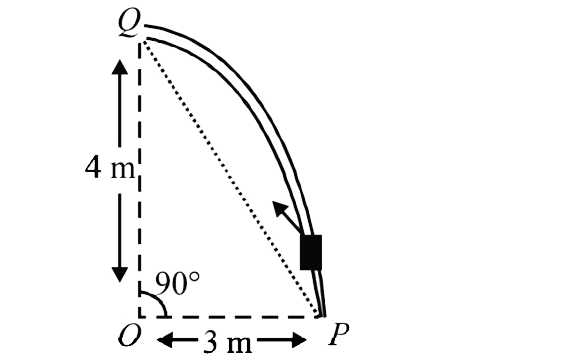Constant as eliptical rail PQ in the varticle plain with OP==3m and OQ=4m . A block of mass 1 kg is pailed along the rail from P to Q with a force of 18N , which is always parallel to less PQ Assuming are frictionless losess , the kinetic energy the block when 0 reches Q is (n×10) pales . THe velie of a (Take acceleration due to gravity ) =10ms−2)

As is clear from figure,
PQ=√OP2+OQ=√32+42=5m
Work done is taking the block from P to Q along elliptically shaped rail,.
W=F×PQ=18×5=90J
Potential energy of block at Q=+mgh
=+1×10×4=+40J
∴K.E. at Q=W−P.E.=90−40=50J=10n
∴n=5

Topper's Solved these Questions
- WORK, ENERGY AND POWERBOOK - PRADEEPCHAPTER - WORK, ENERGY AND POWEREXERCISE - Assertion-Reason Type Questions
24 Videos
- WORK, ENERGY AND POWERBOOK - PRADEEPCHAPTER - WORK, ENERGY AND POWEREXERCISE - Comprehension
9 Videos
- THERMODYNAMICSBOOK - PRADEEPCHAPTER - THERMODYNAMICSEXERCISE - Assertion- Reason Type Questions
19 Videos
Similar Questions
A block of mass M is pulled along a horizontal frictionless surface by a rope of mass m. If a force P is applied at the free end of the rope, the force exerted by the rope on the block will be
View SolutionA block of mass M is pulled along a horizontal frictionless surface by a rope of mass m. If a force P is applied at the free end of the rope , the force exerted by the rope on the block .
View Solution
Knowledge Check
A block of mass 5kg is initially at rest on a rough horizontal surface. A force of 45N acts over a distance of 2m. The force of friction acting on the block is 25N. The final kinetic energy of the block is
A40 JB90 JC50 JD140 JA block of mass M is pulled along a horizontal frictionless surface by a rope of mass m. If a force P is applied at the free end of the rope, the force exerted by the rope on the block is
APm(M+m)BPm(M−m)CPDPM(M+m)A block of mass M is pulled along a horizontal frictionless surface by a rope of mass m . Force P is applied at one end of rope. The force which the rope exerts on the block is:
AP(M−m)BPM(m+M)CPM(m+M)DPM(M−m)
A block of mass "2kg" is placed on the floor.If "a],[" force of "2.8N" is applied on the block parallel at angle of "30" degree from horizontal,then acceleration of block is (takeg=10m/s^(2))
View SolutionA block whose mass is 2 kg is fastened on a spring whose spring constant is 100 Nm−1 . It is pulled to a distance of 0.1 m from over a frictionless surface and is released at t=0. Calculate the kinetic eneryg of the block when it is 0.05 m away from its mean position.
View SolutionA block of mass m = 4 kg is dragged 2 m along a horizontal surface by a force F = 30 N acting at 53∘ to the horizontal. The initial speed is 3m/sandμk=1/8.
Find the change in kinetic energy of the block
View SolutionA block of mass 2 kg is pulled through 3 m by a constnat horizontal force of 10N, along a frictionless horizontal table. What is the work doen by (i) the applied force and (ii) the gravitational force?
View SolutionA block of mass M is pulled along a horizontal frictionless surface by a rope of mass m. If a force P is applied at the free end of the rope, the force exerted by the rope on the block is
View Solution